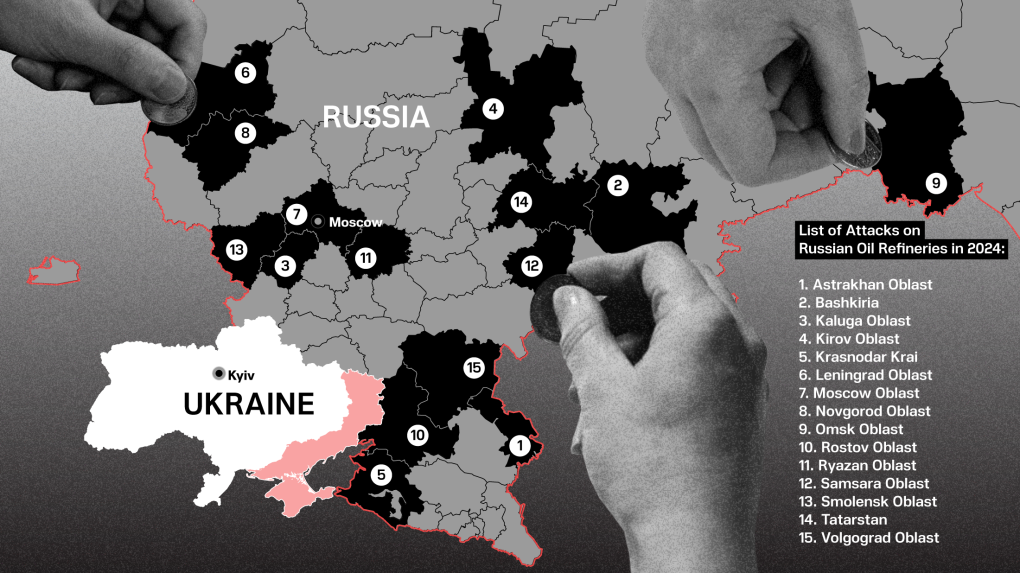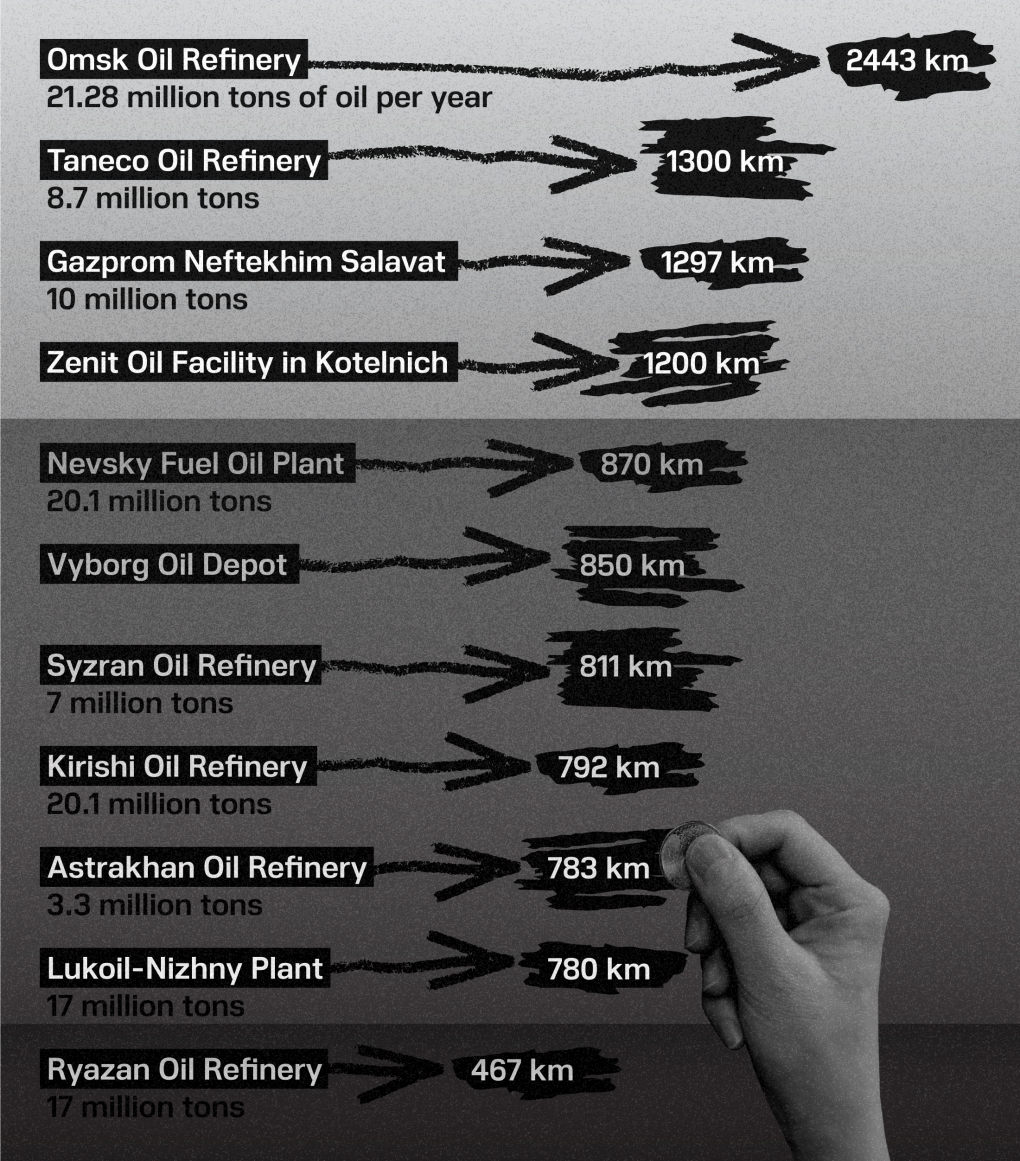- Category
- War in Ukraine
How Many Russian Oil Refineries Has Ukraine Damaged So Far, And Where?

Ukraine had already hit over 30 Russian oil-processing refineries, President Volodymyr Zelenskyy said on June 24th. That was roughly three months ago, and Ukraine has been keeping up the pace since—with drones already reaching a 1,500-kilometer range, according to him.
Since the beginning of the year, Ukraine has attacked oil refineries and infrastructure located in Russia and occupied Crimea and Luhansk at least 64 times, according to the BBC.
Ukraine’s latest stunt hit the Moscow Oil Refinery on September 1st, with videos appearing on social media showing a massive explosion and plumes of smoke over Moscow in one of its biggest-ever drone attacks on Russia over the weekend.
The Konakovo Power Station in the neighboring Tver region, one of the largest energy producers in Russia, was also hit.
Ukraine has managed to hit targets as far as Tatarstan and Bashkortostan. Multiple refineries lost some capacity after the attacks but resumed operations after all.
Ukraine has multiplied its drone attacks on Russian oil depots and refineries since the beginning of the year in a bid to slow down Russia’s war machine by hitting its fuel capacity.

The aim is not only to grind Russia’s army to a halt but also to damage Moscow’s economy, depriving the Kremlin of one of its main sources of revenue. Due to the attacks, Russia’s oil product exports fell by a third in February.
According to a Carnegie Endowment for International Peace report, Ukraine reduced Russia’s oil refining volumes by an estimated 14% as of June. Yet Russia still has a refining capacity that is 2.5 times larger than its own needs, which means Ukraine needs even more long-range drones and missiles to tank Russia’s oil production.
Russia has about 30 large oil refineries and dozens of small ones, producing 530 million tonnes of oil annually.
Here’s where Ukraine has so far managed to hit Russia’s oil refineries in 2024, taking into account that some of the damaged infrastructure was repaired since, only to be hit again.
The list is based on open sources and military confirmation to Ukrainian and international media outlets.
January
Krasnodar Krai: Tuapse plant, damaged but resumed work in April, production capacity: 240,000 bpd (barrels per day).
Leningrad Oblast: Nevsky Fuel Oil Plant, St. Petersburg. Capacity: 20.1 million tons of oil per year.
February
Volgograd Oblast: Lukoil plant, production capacity: 130,000 bpd.
Krasnodar Krai: Ilya and Afip Oil Refineries. The Ilsky refinery processes 6.6 million tons of crude a year and produces more than 7 million tons of aviation fuel per year for military aircraft. The Afip Oil refinery can process 6 million tons of oil per year.
March
Nizhny Novgorod Oblast: Lukoil-Nizhny Plant, in Kstovo, Nizhny Novgorod Oblast, one of the largest in Russia, processes about 5% of Russia’s total oil refining output. Production capacity: 17 million tons of oil per year.
Ryazan, Ryazan Oblast: belongs to Rosneft, the main petrol supplier for Russia's capital regions. Production capacity: about 340,000 bpd or 17 million tons of oil per year.
Krasnodar Krai: Slavyansk-on-Kuban oil refinery, production capacity: 100,000 barrels per day.
Leningrad Oblast: Kirishi Oil Refinery, the second largest refinery in Russia by volume. Production capacity: 20.1 million tons of oil per year.
Kaluga Oblast: First Plant plant. Production capacity: 1.2 million tons per year, roughly 24,000 barrels per day.
Samsara Oblast: Syzran Oil Refinery belongs to Rosneft. Production capacity: 170,000 barrels per day.
Ryazan, Ryazan Oblast: Belongs to Rosneft, main supplier of petrol for the capital regions of Russia. Production capacity at about 340,000 bpd.

April
Tatarstan: Taneco refinery, third-largest in the country, 1.300 kilometers from the front. Production capacity: 155,000 barrels of crude.
Smolensk Oblast: Razdorovo oil depot, Yartsevo oil depot. There are 26,000 cubic metres of Russian fuel and lubricants stored there.
May
Ryazan, Ryazan Oblast: already hit on March 13.
Salavat: Gazprom Neftekhim Salavat, oil processing complex in the Urals region of Bashkiria, Russia's largest such plant, production capacity: 130,000 bpd.
Volgograd plant: belongs to Lukoil, production capacity: 300,000 bpd.
Novorossiisk port and terminals: key outlet for crude and oil operation, resumed a day after the attack, oil loading: 543,000 bpd.
Krasnodar region: Slavyansk oil refinery, production capacity: 100,000 bpd.
Leningrad Oblast: Vyborg oil depot, according to DIU source to UP.
June
Rostov Oblast: Novoshakhtinsk Oil Refinery. The attack reportedly destroyed 1.5 million tons of oil and oil products worth $540 million.
July
Krasnodar Krai: Ilya, Afip Oil Refineries, and Tuapse plant, again, but including the Krasnodarsk Oil Refinery this time.
Astrakhan Oblast: Astrakhan Oil refinery. Production capacity: 703,000 tons of gasoline, or 1.6% of Russia's total.
Volgograd Oblast : oil depot in Kalach-na-Donu.
At that point, Russia’s oil refining capacity was reduced by 17%, according to an unnamed NATO official, quoted by Ukrainska Pravda.
August
Omsk Oblast: Omsk Oil Refinery, owned by Gazprom, lost half of its capacity after the attack.Production capacity: 21.28 million tonnes of oil.
Rostov Oblast: Atlas depot, Rosrezerv oil depot in Rostov Oblast and the Proletarsk oil depot. The Proletarsk oil depot was ablaze for two weeks before the fire could finally be extinguished. Over 10 days, the fire area reached 10,000 square meters.
Kirov Oblast: Zenit oil facility in Kotelnich, located more than 1,200 kilometers from the front.
September
Moscow Oil Refinery and the Konakovo Power Station in neighboring Tver region, one of the largest energy producers in central Russia. Production capacity of the Moscow Oil Refinery: 11.6 million tons of crude oil, operation suspended for at least five to six days.


-f88628fa403b11af0b72ec7b062ce954.jpeg)
-b63fc610dd4af1b737643522d6baf184.jpg)


-29a1a43aba23f9bb779a1ac8b98d2121.jpeg)

-24deccd511006ba79cfc4d798c6c2ef5.jpeg)